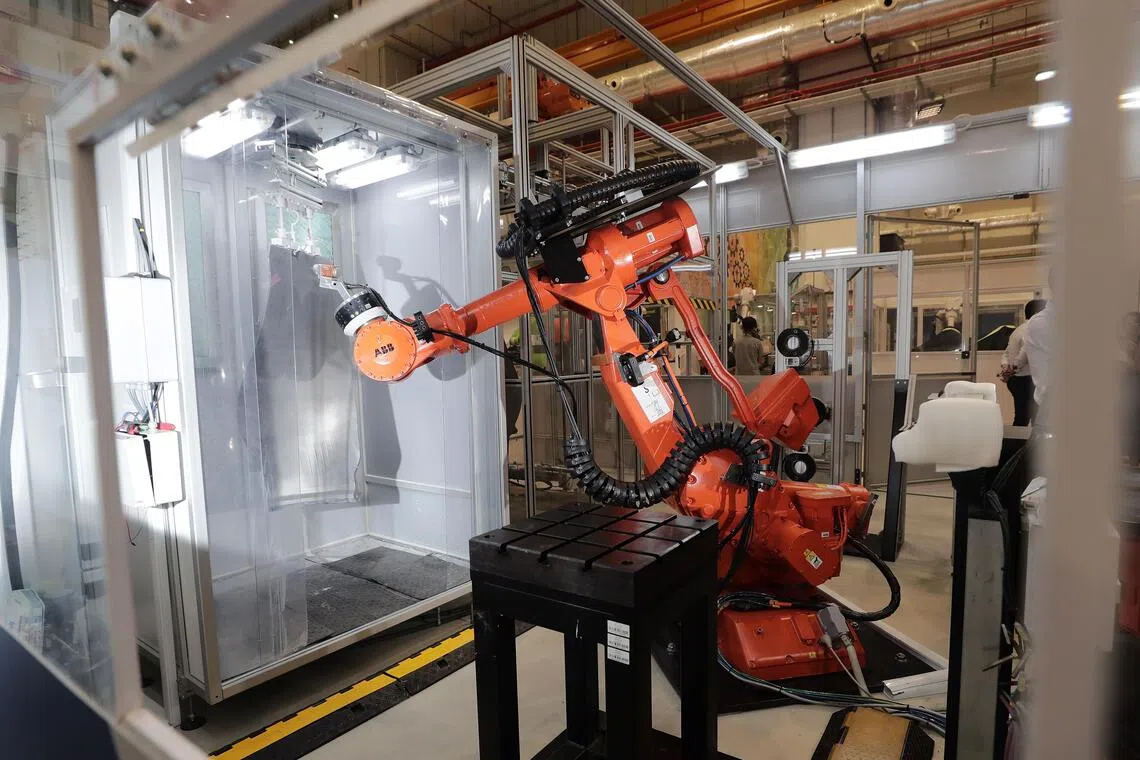Singapore factory activity slips in October as firms take stock of risks ahead
Sign up now: Get ST's newsletters delivered to your inbox

The purchasing managers' index for the broad manufacturing industry slipped in October, while that of the electronics sector marked its fifth straight month of expansion.
PHOTO: ST FILE
Follow topic:
- Singapore's October PMI was 50, slower than September's 50.1 amid global economic uncertainties.
- The electronics sector expanded for the fifth month, boosted by AI demand and US tariff exemptions.
- Falling factory output and business indexes signal slowing momentum as geopolitical risks and potential US semiconductor tariffs loom.
AI generated
SINGAPORE - Singapore’s manufacturing output slowed in October but stayed out of contraction territory as businesses evaluated geopolitical and economic risks heading into the final months of 2025.
The purchasing managers’ index (PMI) – a barometer of the overall manufacturing industry’s health – slipped from 50.1 points in September to 50 points in October.
The electronics sector, which accounts for 40 per cent of manufacturing output, recorded a PMI of 50.4 points, marking its fifth straight month of expansion.
A PMI reading above 50 indicates growth; one below suggests a contraction in output.
The manufacturing industry remains on an expansionary path “despite persistent policy uncertainties in the global economy”, said Mr Stephen Poh, executive director at the Singapore Institute of Purchasing and Materials Management, which gathers and compiles the monthly survey.
However, he added: “Geopolitical risks have become increasingly intertwined with economic risks, leaving export-dependent economies such as Singapore vulnerable to supply chain disruptions and rising operational costs.”
US President Donald Trump’s move to impose tariffs on virtually every country in the world in April has shaken financial markets and put pressure on firms that target American consumers, although he has since agreed to roll back tariff rates on some countries and grant several major businesses reprieves.
In a meeting in South Korea last week, Mr Trump and Chinese President Xi Jinping also agreed to de-escalate tensions, with the US delaying some of its so-called reciprocal tariffs on China for another year.
The manufacturing industry saw faster expansion rates in the indexes of imports and input prices. It saw a slower expansion rate in the indexes of new orders, new exports, and input purchases.
OCBC Bank’s chief economist Selena Ling told The Straits Times it is notable that the factory output and supplier deliveries indexes slipped into contraction. The future business index also marked its seventh straight month of contraction, despite posting a slower contraction rate.
Ms Ling said these can be taken as “warning signs for slowing momentum ahead”.
“Looking at the broader Asian manufacturing PMIs, there is also a softening for Malaysia, South Korea and Taiwan, likely due to headwinds from softer global and US demand and also weaker downstream demand from China,” she added. Private PMI releases for October also showed manufacturing activity growing at a slower pace in China and falling in South Korea, with export orders in both countries declining.
In Singapore, the electronics sector continued to outpace the broader industry, despite its PMI easing by 0.3 points from September’s 50.7 points. It recorded a slower expansion rate in the indexes of new orders, new exports, factory output, input purchases, and employment. The gauges of imports and input prices accelerated, while the supplier deliveries index reverted to a moderate expansion.
DBS Bank’s senior economist Chua Han Teng said the sector has benefitted from US tariff exemptions on electronic goods. It is also seeing a flow of new orders, driven by demand related to artificial intelligence (AI).
“The electronics cluster could hold up for some time, supporting the overall manufacturing sector until threatened US semiconductor tariffs are announced and implemented, with the ultimate downside impact dependent on the eventual conditions,” Mr Chua said.
Ms Ling said electronics output outside the US could also be hit in the future as semiconductor firms agree to bring more production and foreign direct investment to America, as part of negotiations with the Trump administration.
“That said, the recent US corporate earnings results point to ongoing strong AI capex investments and cloud infrastructure demand, so the electronics momentum may sustain slightly longer than the broader manufacturing picture,” she added.


